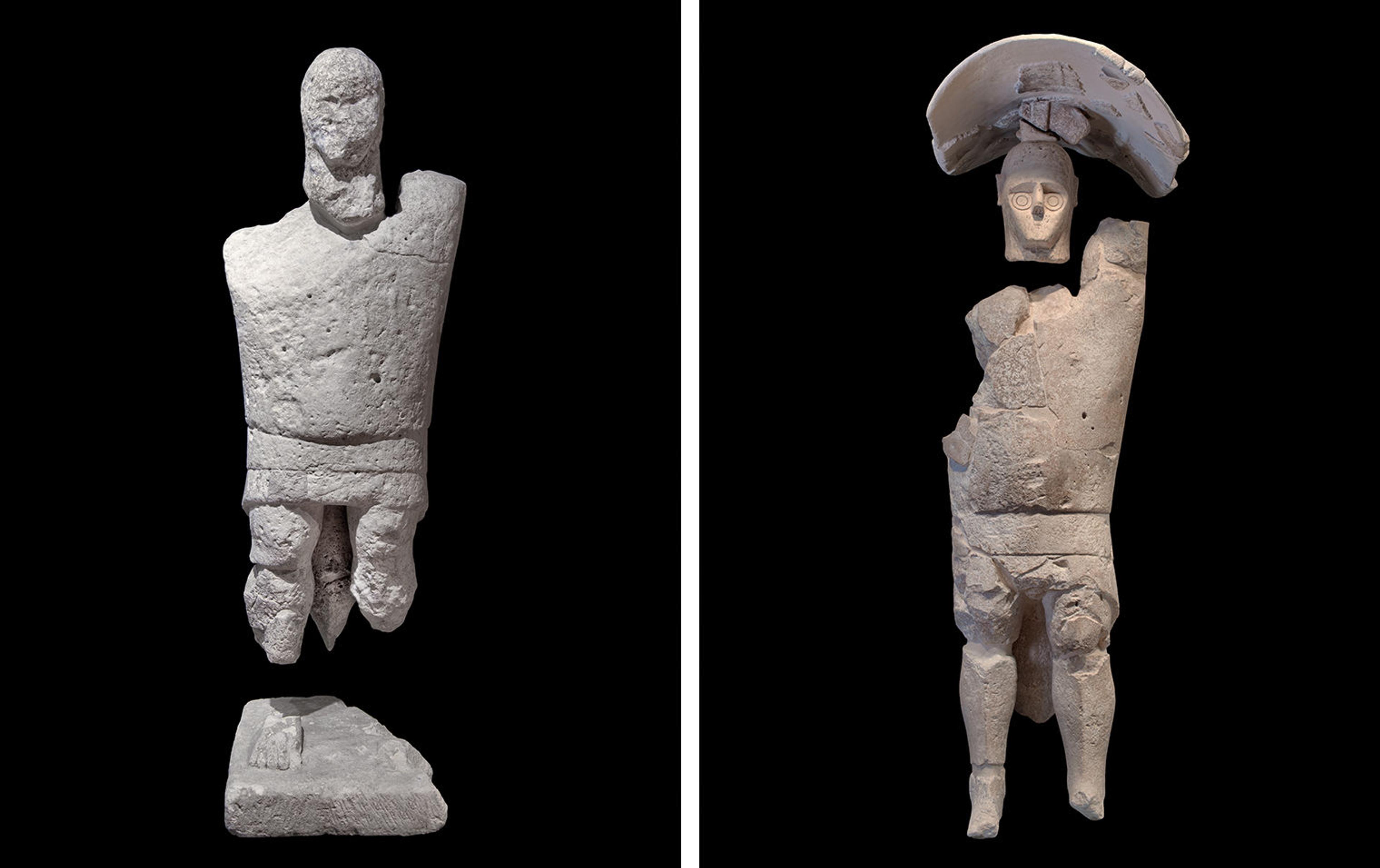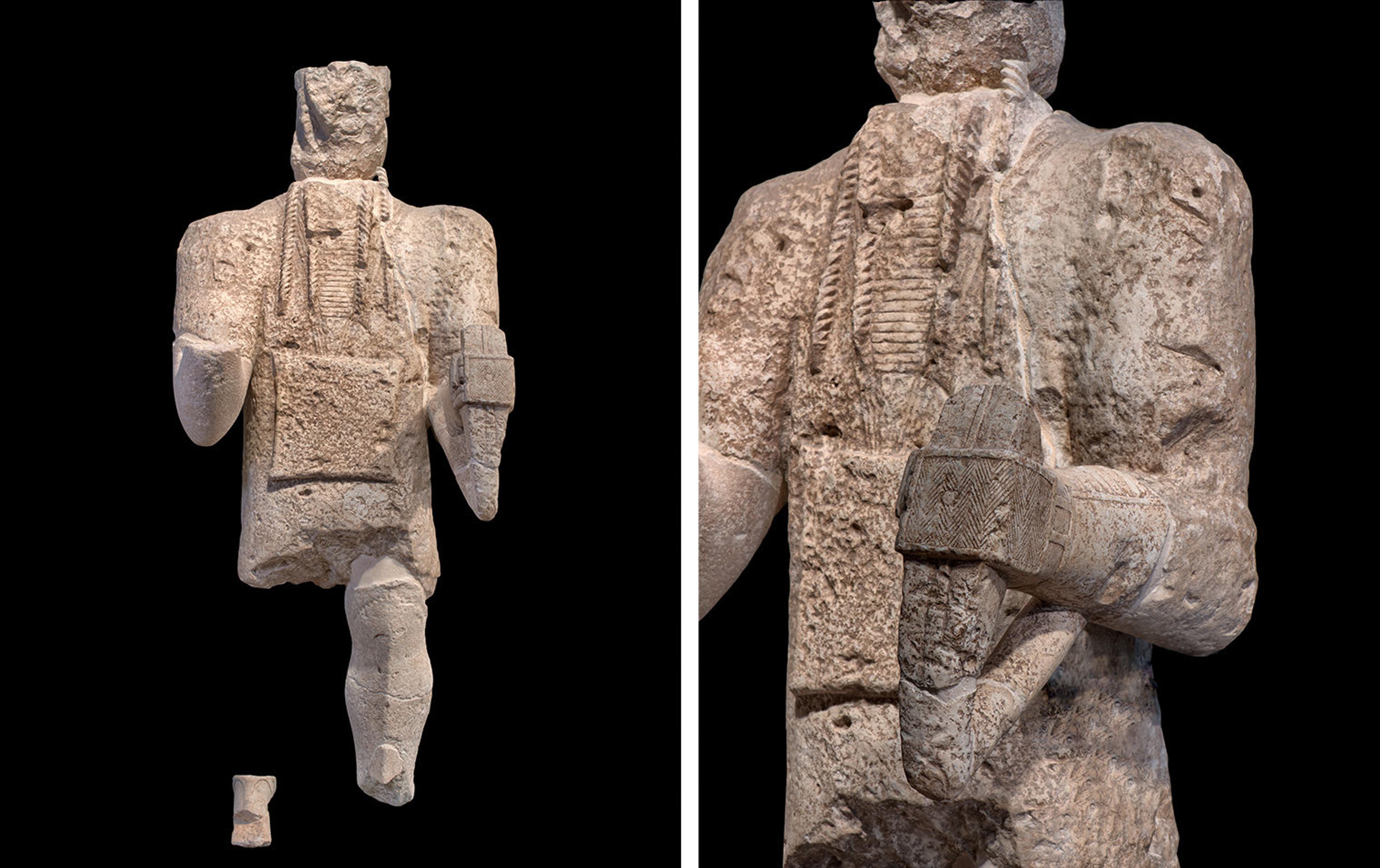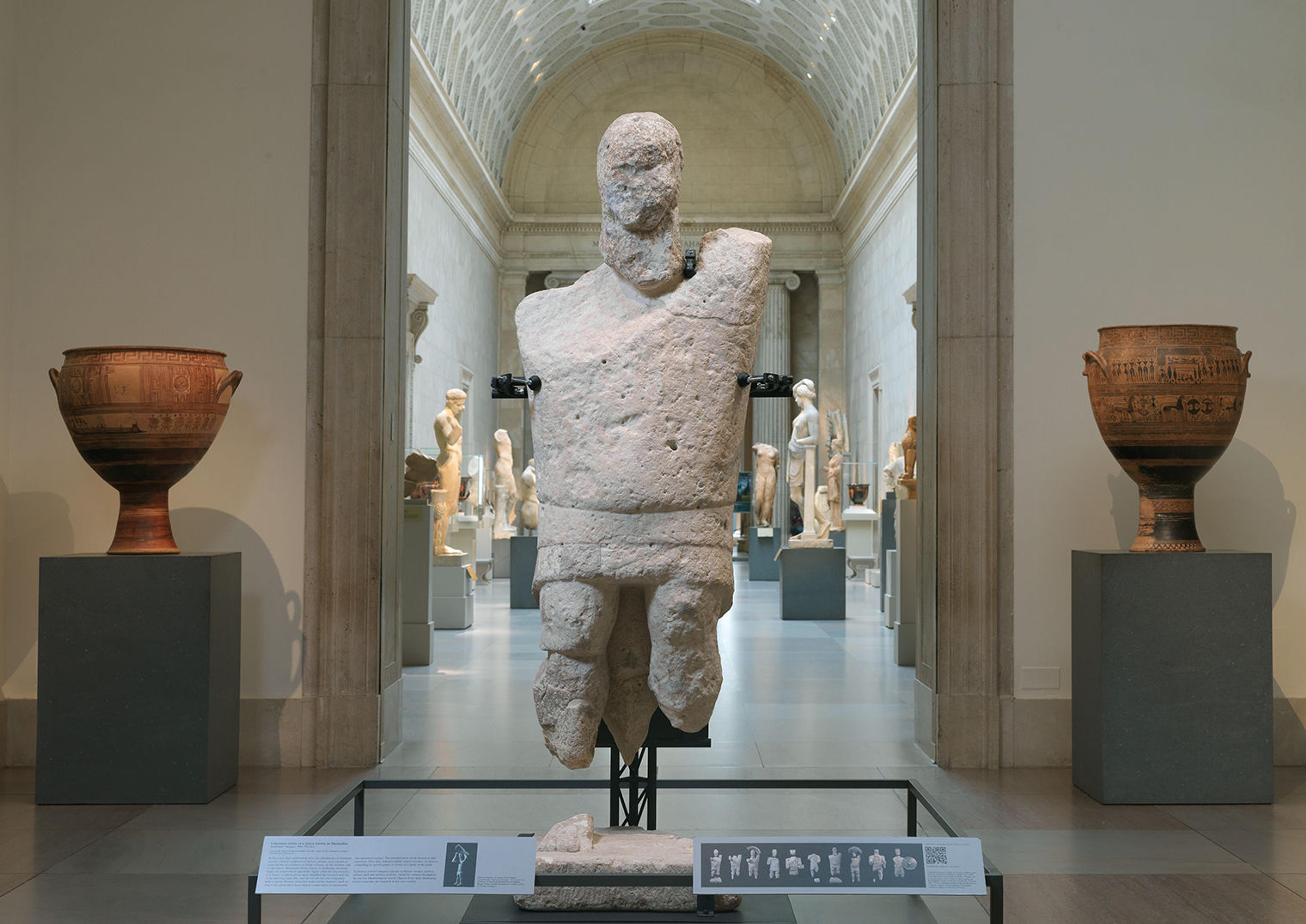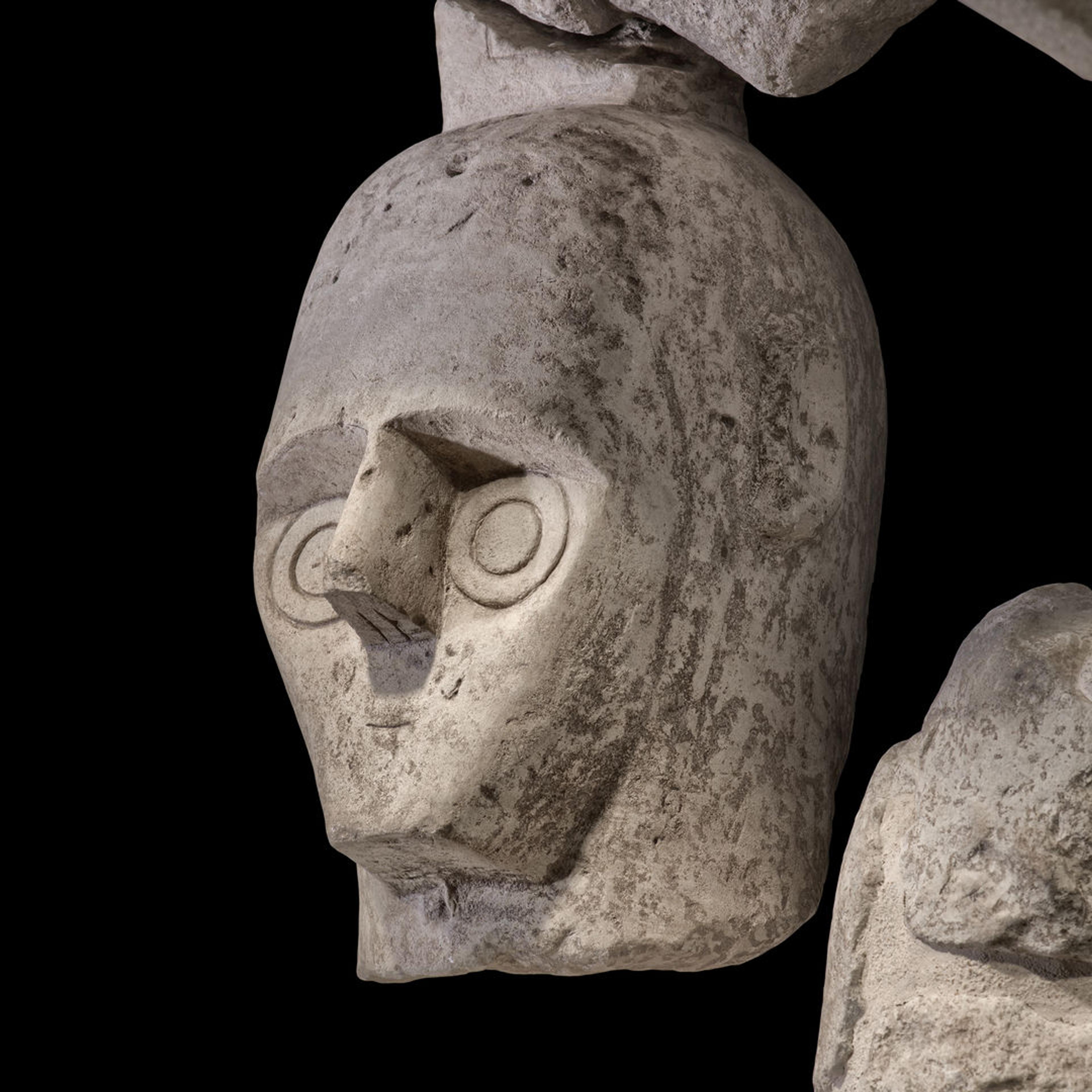A Giant Discovery
In 1974, two farmers plowing their field in western Sardinia unearthed a nearly three-thousand-year-old gigantic limestone head, the first of thousands of ancient sculptural fragments recovered by archaeologists in the following decades. Excavations in the plain at the foot of the low hill of Mont’e Prama (“the mountain of palm trees”) revealed a monumental necropolis, or funerary area, that had been in use for several centuries during the early first millennium BCE.

Left: View of the necropolis at Mont’e Prama. Photo by Nicola Castangia. Right: Map of Sardinia
The extraordinary site features individual tombs covered with stone slabs, colossal male statues, sacred stones known as baetyls, and models of nuraghi, the prehistoric towers of Sardinia that give their name to the Nuragic culture that flourished on the island from about 1700–700 BCE. The imposing group of sculptures, known as the Giants of Mont’e Prama, are currently dated between 900–750 BCE. Remarkably, they are the only examples of stone statuary discovered so far from the Nuragic period, unparalleled at any other site on the island.

Limestone boxers, archers, and warriors excavated from the necropolis at Mont’e Prama (Manneddu fourth from the right). Courtesy Mont’e Prama Foundation Archives, photo by Nicola Castangia
Conservators have now reassembled twenty-eight figures—some as tall as seven feet—from fragments excavated in the 1970s. At the time of their restoration, each statue was given a modern name. New excavations starting in 2014 have uncovered thousands of additional pieces, and at least eighty sculptures (including nuraghi models) in varying states of preservation are now known. Based on the better-preserved statues, shared features, and comparison with bronze statuettes, three distinctive types of figures have been identified: boxers, archers, and warriors. Many details missing in the reconstructed statues are known from fragments that could not be matched with a more complete figure.
The largest of the Giants, a boxer named Manneddu (from mannu in Sardinian, meaning large), is on view in The Met’s Greek and Roman galleries through December 2023 as a six-month loan from the Mont’e Prama Foundation. He is the first Giant to be exhibited in the United States and offers visitors the rare opportunity to explore this little-known ancient culture, which is not represented at all in The Met’s collection.

Left: Limestone statue of the boxer Manneddu, from the necropolis at Mont’e Prama, 900–750 BCE. Sardinian, Nuragic. Limestone, H. 77 ¼ in. (1.96m). Right: Limestone statue of the boxer Fastigiadu, from the necropolis at Mont’e Prama, 900–750 BCE. Sardinian, Nuragic. Limestone. Both images courtesy Mont’e Prama Foundation Archives, photos by Nicola Castangia
Boxers, Archers, and Warriors
The boxers make up the greatest number of reassembled sculptures but are also the most challenging to interpret. Manneddu stands bare-chested, wearing only a cap and a garment wrapped around his waist. The forearm and fist of his missing right arm were originally protected by a sort of battle glove with a projecting spike. The best-preserved examples, such as the boxer Fastigiadu, hold a curved rectangular shield above their heads. Although the glove is not included in the reconstructed statues, it appears in the fragments. The spike has been interpreted as the tip of a traditional Nuragic dagger with the guard bent to protect the gloved hand. The boxers, some of whom exhibit wounds with traces of red pigment on the legs and chest, may represent either lightly armed warriors equipped for close combat or gladiator-style athletes competing in sacred, yet bloody, games in honor of a deity or the dead.

Left: Limestone statue of the archer Prexiau, from the necropolis at Mont’e Prama, 900–750 BCE. Sardinian, Nuragic. Limestone. Right: Detail of Prexiau’s bow. All images courtesy Mont’e Prama Foundation Archives, photos by Nicola Castangia
The archers and warriors wear distinctive attire and are identified by the weapons they carry. As they are fully armed, the types may represent different military ranks. However, like the boxers, their specific role in Nuragic culture is unclear. The archer Prexiau wears a short tunic, rectangular breastplate, and greaves (shin guards). His left arm, protected by an armguard, holds the bow, while his right forearm raises a clenched hand, now missing, in a gesture that has been interpreted as a sign of greeting or prayer. The heads of the archers are not well-preserved, but some of the figures, like Prexiau, have long plaits of hair falling over their shoulders.

Limestone statue of the warrior Gherreri, from the necropolis at Mont’e Prama, 900–750 BCE. Sardinian, Nuragic. Limestone. Both images courtesy Mont’e Prama Foundation Archives, photos by Nicola Castangia
The warriors also wear armor over a short tunic, but in different styles. A breastplate with vertical segments protects the upper body of the warrior Gherreri and a fringed panel with geometric patterns hangs from the waist of his tunic. A helmet with a central ridge and two horns, only partially preserved, covers his head. The warriors’ main defense is a large round shield on the left arm, while the right hand holds a long sword resting on the shoulder. The missing details are reconstructed based on comparison with bronze statuettes of the same type.

Left: Bronze statuette of a boxer from Dorgali, Cala Gonone, 9th century BCE. Sardinian, Nuragic. Bronze. National Archaeological Museum of Cagliari. Middle: Bronze statuette of an archer from Alà dei sardi, Su pedrighinosu, 9th century BCE. Sardinian, Nuragic. Bronze, H. 6 in. (15 cm). National Archaeological Museum of Cagliari. Right: Bronze statuette of a warrior from Senorbì, Santu Teru, 9th century BCE. Sardinian, Nuragic. Bronze. National Archaeological Museum of Cagliari. All images courtesy Mont’e Prama Foundation Archives, photos by Nicola Castangia
All of the sculptural groups—boxers, archers, and warriors—correspond visually with Nuragic bronze statuettes of the same period. These small figures have helped conservators to reassemble the fragmentary Giants because of their similar features. The statuettes have been found in sites across Sardinia, but few come from known contexts. Those that do seem to have served as offerings to deities in sanctuaries. Despite their related iconography, however, no bronze statuettes have been discovered at Mont’e Prama. In fact, aside from pottery, excavations have recovered very few finds, including grave goods, from the necropolis.
The Heroes of Mont’e Prama
As no written records of the Nuragic culture have been discovered, the archaeological remains provide the only evidence for understanding the nature of the necropolis and the significance of the Giants. Excavations revealed that the site had been in use for several centuries, with each period marked by a different type of tomb. In the last phase, dated to the end of the ninth to the first half of the eighth century BCE, individual graves were covered by square stone slabs and arranged in a line along the edge of a funerary road as shown in the aerial view below. It was during this period that the Giants were erected.

Aerial view of part of the necropolis showing the tombs arranged along the funerary road. Photo by Valentino Selis
The original arrangement of the sculptures with respect to the stone-covered tombs is not known. Recent research suggests that the statues were broken in antiquity, sometime after the site went out of use, and then intentionally laid above and next to the graves. It is unclear whether the figures once stood along the road evoking a monumental funerary procession, on top of the slabs covering the tombs as grave markers, or elsewhere serving an entirely different function. The meaning of the Giants is similarly obscure. The iconography, focused on athletic skill and military prowess, reflects values and traditions appropriate for an emerging aristocratic class. In fact, analysis of the human remains seems to confirm that the necropolis was used almost exclusively for adolescents and young men. The statues may refer to some sort of religious rituals—possibly initiation rites of youths into the military ranks—that took place in the funerary complex. If so, the necropolis may have been reserved for the burial of those who distinguished themselves in battle or competition, with the Giants as markers of their heroic stature.

Installation shot of Manneddu in The Met’s Greek and Roman galleries
Many key questions about Manneddu and the other Giants of Mont’e Prama remain unanswered—including what community or communities were responsible for their creation and why they began carving large-scale, freestanding sculpture at that time. The Giants appeared during a period of increasing overseas contact, and the reasons for erecting the enormous statues may have been part of a response to these new cultural interactions. Ongoing excavations at Mont’e Prama continue to reveal new insight into the intricacies of the necropolis and the relationship between the site and the surrounding region, as well as the broader Mediterranean world.
Further Reading
Faedda, Barbara and Paolo Carta, eds. A Lost Mediterranean Culture: The Giant Statues of Sardinia’s Mont’e Prama. New York: Columbia University Press, 2023.
Doria, Federica, et al., eds. Sardinia Megalithic Island: From Menhirs to Nuraghi: Stories of Stone on the Heart of the Mediterranean. Milan: Skira, 2021.
Usai, Emerenziana and Raimondo Zucca. Mont'e Prama (Cabras). Le tombe e le Sculture. Sassari, Sardinia: Carlo Delfino Editore, 2015.
Boninu, Antonietta and Andreina Costanzi Cobau, eds. Le sculture di Mont’e Prama Vol. 1. Conservazione e Restauro. Rome: Gangemi Editore. 2014.
Usai, Alessandro, ed. Le sculture di Mont’e Prama Vol. 2. La mostra. Rome: Gangemi Editore, 2014.
Minoja, Marco and Alessandro Usai, eds. Le sculture di Mont’e Prama Vol. 3. Contesto, scavi e materiali. Rome: Gangemi Editore, 2014.
